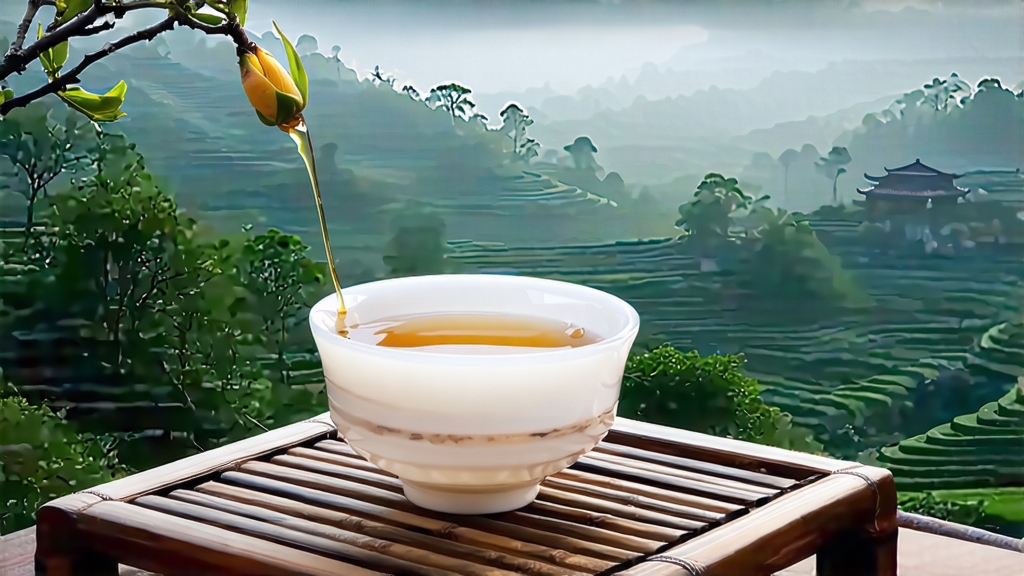
Tucked above the perpetual cloud belt of Sichuan’s Ya’an region, the misty summit of Mt. Meng has been whispering tea secrets for more than twelve centuries. Among the craggy limestone ridges, where monkeys once outnumbered monks, a single cultivar of tea bush produces what Chinese emperors once called “the liquid sunrise of the west”—Meng Ding Huang Ya, the yellow bud that taught China how to taste time.
Historical roots
The first written record appears in a Tang-dynasty county gazetteer (AD 808) that lists “Meng Mountain yellow shoot” as tribute. During the Song, imperial caravans carried the tea northward along the Tea-Horse Road, exchanging it for Tibetan warhorses; the compressed cakes were stamped with a golden phoenix seal reserved for only three teas nationwide. When Ming tea masters shifted from compressed bricks to loose leaf, Meng Ding Huang Ya survived because its unique slow-yellowing process could not be replicated in the lowland factories. By the late Qing the tea had all but vanished, victim to civil war and British-export pressure for quick-fermented black leaf. Rediscovery came in 1959 when a Sichuan agricultural team located three ancient bushes still clinging to a cliffside monastery garden. Cuttings were propagated, state-secret process notes were decoded, and the yellow bud returned to the market just in time for the 1980s gourmand renaissance.
Micro-terroir
Mt. Meng’s apex sits at 1,456 m, high enough to trap cool, humid air yet low enough to escape winterkill. Basalt soils rich in fluorine and selenium feed the local xiao-ye-zhong (small-leaf landrace) bushes, while diurnal swings of 15 °C slow photosynthesis, stacking amino acids—especially theanine—into every nascent bud. Spring fog filters UV-B light, so leaves synthesize less catechin bitterness and more floral lactones. The result is a raw leaf that already tastes sweet before any human hand touches it.
Plucking etiquette
The harvest window opens for only ten days each year, beginning when the last plum rain drips off the camellia blossoms—usually 20 March to 1 April. Two standards prevail: “imperial grade” (one unopened bud) and “noble grade” (bud with the first leaf just unfurling, the so-called “sparrow’s tongue”). Pickers must finish plucking before 09:00, when mountain mist lifts and dew evaporates; any later, surface moisture triggers uneven enzymatic browning during yellowing. Bamboo baskets are lined with fresh banana leaves to prevent mechanical bruising, and the cargo is carried downhill on foot within two hours—no wheeled transport is allowed, because vibration ruptures cell walls and oxidizes the leaf prematurely.
Crafting the yellow soul
Meng Ding Huang Ya is the textbook example of the “sealed yellowing” technique, a six-step choreography that sits between green and black tea methods yet belongs to neither.
- Gentle kill-green: 4 cm of leaf is tumbled for 90 seconds in a 160 °C bamboo-roasted wok, hot enough to denature polyphenol oxidase but brief enough to keep 8 % residual moisture.
- Initial rolling: The warm leaf is wrapped in linen and hand-rolled for eight minutes, breaking 30 % of cells to release sap while preserving bud integrity.
- First piling: Rolls are packed into oak boxes lined with wet cotton; temperature is held at 28 °C for four hours. Chlorophyll begins to degrade into pheophytin, the first visual shift from jade to pale primrose.
- Second firing: Leaf is re-dried at 80 °C for six minutes to stop rampant oxidation, then cooled on sieves for one hour.
- Second piling (the “golden pause”): The critical 36-hour sealed rest. Humidity 75 %, temperature 32 °C, boxes stacked only three high to prevent compaction. Here the magic unfolds: flavonols glycosylate, giving a honeyed aroma; protein-bound amino acids release free glutamic acid, building broth-like sweetness; carotenoids fragment into β-ionone, the scent of orchards after rain.
- Slow final bake: Leaf is charcoal-baked at 55 °C for two hours, rested for a day, then baked again at 45 °C until moisture drops to 5 %.